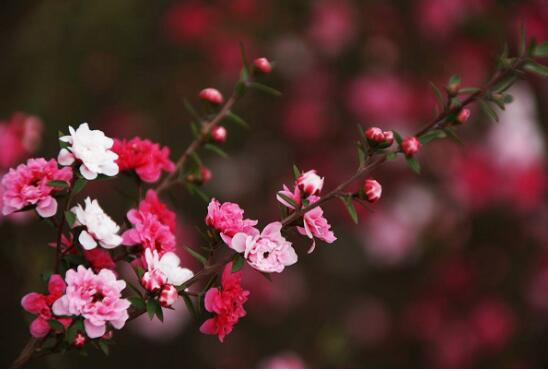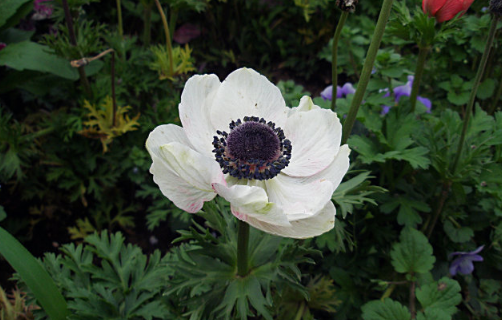Culture method of Songhongmei
1. Sufficient light
Songhongmei likes a sunny environment and is afraid of cold places, so it should give Songhongmei plenty of sunshine. However, we should pay attention to the sunshade treatment of Songhongmei in the hot summer.
2. Timely fertilization
Although Songhongmei is not strict with the soil, it grows best in the slightly acidic soil with fertile, loose and good drainage, so it is necessary to apply fertilizer in time. It is best to apply fertilizer once a month or two months during the growing period.
2. Control moisture
Pine red plum likes a cool, humid environment, usually to keep its soil moist, but to avoid stagnant water, pay attention to drainage.
4. Reasonable pruning
If you want pine and red plum to grow well, in addition to watering and fertilizing, of course, you should also pay attention to the pruning of pine and red plum! Special attention should be paid when pruning, not all the branches of Songhongmei can be cut off. In addition to its old and diseased branches, the other branches can be cut by half or 2/3.

Finally, what I bring to you is the flower words of Songhongmei-victory, high rise and firmness.
OK, the above is the introduction of the flowering period and breeding skills of Songhongmei. I hope these contents can help you. Thank you for reading!
Culture method of Songhongmei
Culture method of Songhongmei
Now more and more flower friends are impressed by pine and red plum, its flowers are very beautiful, semidouble, let's learn about the breeding methods of pine and red plum, pine and red plum like cool and humid, sunny environment, avoid hot and humid climate, maintenance is relatively difficult.
The optimum growth temperature of Songhongmei is 18 ℃-25 ℃. Winter requires to maintain a temperature of more than 1 ℃, summer is afraid of high temperature and hot sun exposure, other seasons should be given sufficient light. Some protective measures should be taken in hot summer and cold winter areas, such as shade shed, shade F or other cool and ventilated places in summer, sprinkling water to cool down, covering grass in winter or planting in the south side of the building to protect the microclimate. Indoor potted plants are maintained in winter in the north.
Songhongmei has strong drought tolerance (but according to the feedback of flower friends, potted plants, too dry and immediately turn over, so you can consider appropriate humidity), the requirements on the soil are not strict, but the slightly acidic soil rich in humus, loose and fertile, well-drained is the best, avoid high temperature and humidity, and strictly prevent poor drainage and long-term stagnant water.
Pine red plum usually has a plant height of about 2m and slender branches, such as untimely pruning management, easy crazy growth and loose plant type, but it is resistant to pruning and strong branching ability, which can be used from
The young plant began to prune to make it sprout new branches and control the reasonable plant type, which could be shaped into a beautiful plant type after 2 years, with large flowering quantity and dense branches.
One of the two points that should be paid attention to in the process of shaping and pruning is that except for some branches that affect the plant type, the other branches should not be completely cut off. If the pruning is too heavy, leaving only the Lignified branches, it will be difficult to restore growth. Second, fertilize immediately after each pruning, mainly phosphorus and potassium fertilizer, and control the amount of nitrogen fertilizer to promote flower bud differentiation and ensure flowering in the second year.
Culture method of Songhongmei
The cold tolerance of Songhongmei is not very strong, and the temperature should be kept above-1 ℃ in winter, so it can only be watched in pots in the north, and can be used for courtyard greening in the south with mild climate.
Songhongmei is native to New Zealand, Australia and other regions, like cool, moist, sunny environment. The cold tolerance of Songhongmei is not very strong, and the temperature should be kept above-1 ℃ in winter, so it can only be watched in pots in the north, and can be used for courtyard greening in the south with mild climate. Songhongmei is not strict on soil, but it grows best in slightly acidic soil which is rich in humus, loose and fertile, and well drained. The suitable temperature for its growth is 18 ℃ ~ 25 ℃. It is afraid of high temperature and hot sun in summer, so it can be maintained in shade, shade or other cool and ventilated places, and sufficient sunlight should be given in other seasons.
During the growing period, a mature thin liquid fertilizer is applied every 1 to 2 months to keep the soil moist at ordinary times and pay attention to drainage in the rainy season to avoid long-term stagnant water.
A careful pruning is carried out after flowering every year to achieve the purpose of dwarfing the crown, maintaining the beauty of the tree, and promoting the plant to sprout new flowering branches. When pruning, it should be noted that except for some branches that affect the plant type can be completely cut off, other branches can not be completely cut off, generally cut off half or 2/3. Because there is no vitality bud on the mature Lignified branches of Songhongmei, if the pruning is too heavy, leaving only the old branches, the plant will not be able to restore growth.
After pruning, a quick-acting inorganic fertilizer was applied to promote plant growth and ensure flowering in the second year. As the root system of Songhongmei is close to the soil surface, we should avoid turning the soil as far as possible so as not to damage the root system.
- Prev

Culture skills of anemone
Before planting anemone, soak the root with water for 1-2 days to make the anemone seed absorb water and expand. 3 parts of garden soil, 1 part of rotten leaf soil and 1 part of rice chaff ash, 1 handful of rotten compost or chicken manure in each pot. 3-5 balls can be planted in a basin with a diameter of 20 cm. When planting, the tip of the root should be downward, not upside down.
- Next

Maintenance method of Songhongmei in four Seasons
Songhongmei can survive all the year round, and there are some maintenance methods in each season. 1. Provide sufficient light to Songhongmei in spring and spring, but also avoid direct sunlight. After the spring flowering period, we should pay attention to pruning Songhongmei to avoid excessive crown growth and increase the aesthetic function at the same time.
Related
- Fuxing push coffee new agricultural production and marketing class: lack of small-scale processing plants
- Jujube rice field leisure farm deep ploughing Yilan for five years to create a space for organic food and play
- Nongyu Farm-A trial of organic papaya for brave women with advanced technology
- Four points for attention in the prevention and control of diseases and insect pests of edible fungi
- How to add nutrient solution to Edible Fungi
- Is there any good way to control edible fungus mites?
- Open Inoculation Technology of Edible Fungi
- Is there any clever way to use fertilizer for edible fungus in winter?
- What agents are used to kill the pathogens of edible fungi in the mushroom shed?
- Rapid drying of Edible Fungi

